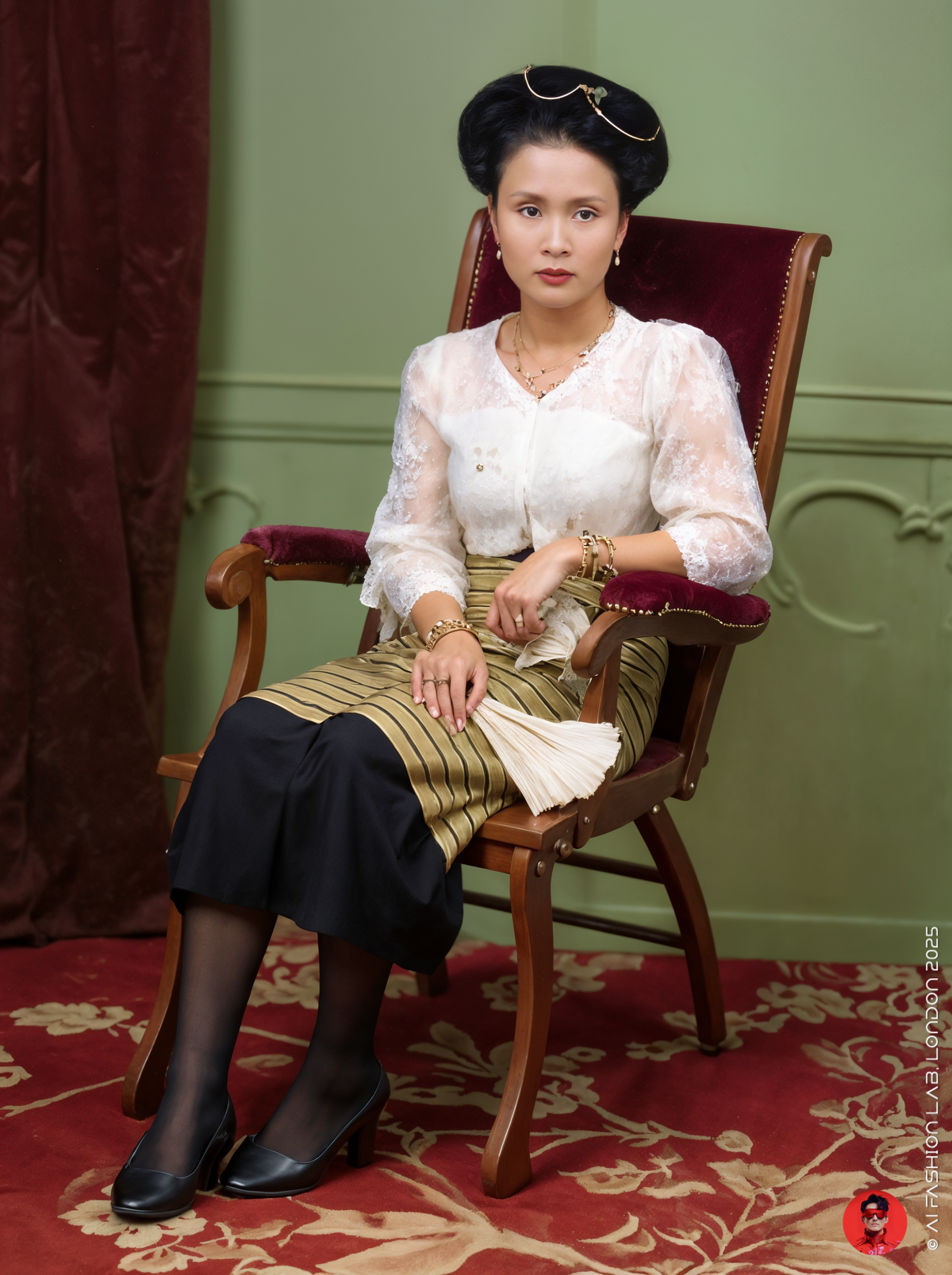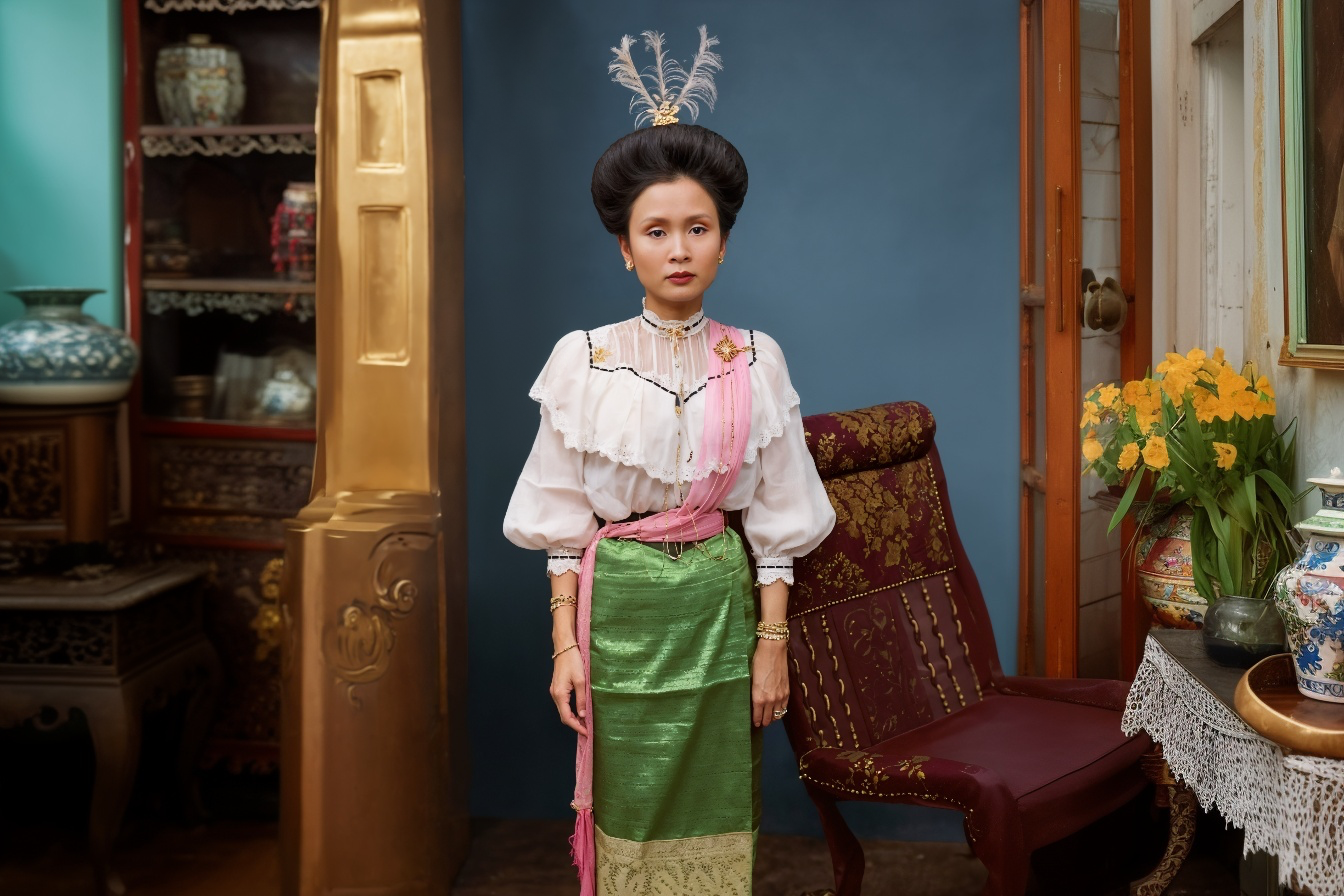เจ้านางสำเปาคำ (เจ้าหญิงศรีนวล) ณ ลำปาง
เจ้านางสำเปาคำ (เจ้าหญิงศรีนวล) ณ ลำปาง
เจ้านางสำเปาคำ ณ ลำปาง หรือเจ้าหญิงศรีนวล ณ ลำปาง สตรีผู้มีอำนาจ แห่ง คุ้มหลวงนครลำปาง เจ้านายลูกหลานในคุ้มหลวง บางคนก็เรียกท่านว่า แม่เจ้า ,เจ้าแม่ ,เจ้าแม่เฒ่า เจ้าหญิงศรีนวลเป็นราชธิดาองค์โตในเจ้าหลวงบุญวาทย์วงศ์มานิตย์กับแม่เจ้าเมืองคำชื่น ราชเทวีแห่งนครลำปาง ทรงเป็นสตรีสูงศักดิ์ผู้ทรงอำนาจและทรงอิทธิพลที่สุดรองจากพระบิดาในคุ้มหลวงนครลำปาง ด้วยพระอุปนิสัยเด็ดเดี่ยว กล้าตัดสินใจ และทรงหวงแหนเกียรติแห่งการเป็นราชธิดาเจ้าเมือง เจ้าหลวงบุญวาทย์จึงไว้วางพระทัยอย่างยิ่ง หลังการสิ้นพระชนม์ของพระมารดา ได้มอบหมายให้พระธิดาองค์นี้ดูแลกิจการทุกประการในคุ้ม ตั้งแต่ห้องพระคลัง การถือกุญแจสมบัติของตระกูล การจัดการด้านการเงิน ไปจนถึงการจ่ายเบี้ยหวัดแก่เจ้านาย โอรส–ธิดา และหม่อมภรรยาทั้งหลาย พระองค์จึงเปรียบเสมือนเสาหลักฝ่ายในของคุ้มหลวงที่ได้รับความเกรงขามจากทั้งเจ้านายและบริวาร
เจ้าหญิงศรีนวลทรงสมรสครั้งแรกกับเจ้าหม่อม ณ ลำปาง และมีธิดาคือเจ้าอบ ณ ลำปาง ต่อมาทรงสมรสครั้งที่สองกับเจ้าราชบุตรแก้วเมืองพรวน (สุริยะ ณ ลำปาง) และมีบุตร–ธิดารวม 6 พระองค์ ได้แก่ เจ้าหญิงสร้อยแก้ว เจ้าวงศ์เกษม เจ้าหญิงฟองสมุทร เจ้ามงคล เจ้าหญิงบุญศรี และเจ้าหญิงศรีโสม หลังการพิราลัยของเจ้าหลวงบุญวาทย์ อำนาจของตระกูลตกอยู่ในความขัดแย้งระหว่างฝ่ายเจ้าราชวงศ์แก้วปราบเมรุ ผู้มีฐานันดรสูงสุดในตระกูล ณ ลำปาง ขณะนั้น กับฝ่ายเจ้าราชบุตรแก้วเมืองพรวน พระสวามีของเจ้าหญิงศรีนวล พระองค์ได้กล่าวถ้อยคำที่เป็นตำนานว่า “หากเจ้าเกิดมาเป๋นจาย ข้าเจ้าก็จักได้เป็นเจ้าหลวงองค์ถัดไปตามศักดิ์และสิทธิ์” ความขัดแย้งนี้นำไปสู่การฟ้องร้องและโต้แย้งกันยืดเยื้อ จนท้ายที่สุดมีข้อตกลงให้เจ้าราชบุตรแก้วเมืองพรวนขึ้นดำรงตำแหน่ง “เจ้ารั้งนครลำปาง” อันเป็นตำแหน่งในนาม เพื่อรักษาความมั่นคงของตระกูล แม้ตามลำดับขันธ์ศักดิ์แล้ว “เจ้าราชวงศ์” จะอยู่เหนือ “เจ้าราชบุตร” ก็ตาม
บทบาทของเจ้าหญิงศรีนวลเป็นที่กล่าวขานว่าพระองค์เคยทำหน้าที่ผู้ว่าราชการแทนพระบิดาเมื่อครั้งเสด็จไปรับราชการที่กรุงเทพฯ อีกทั้งยังผลักดันให้พระสวามีได้รับสิทธิ์ขึ้นเป็นผู้นำตระกูล ทรงบุกเบิกกิจการในคุ้มหลวงหลายประการ ทั้งค่ายมวย บ่อนไพ่ และการต้มสุรา พระนามของพระองค์ยังเคยถูกเสนอให้ถวายตัวเป็นเจ้าจอมในรัชกาลที่ 5 แต่พระราชชายาทรงห้ามไว้ด้วยความห่วงใย นอกจากนี้ยังทรงเป็นหัวเรือใหญ่ในการต้อนรับเจ้านายจากราชวงศ์จักรีที่เสด็จเยือนลำปาง และเป็นสตรีคนแรกของจังหวัดที่บริจาคเงินซื้อเครื่องบิน รวมถึงได้ขึ้นบินเป็นคนแรกในลำปางด้วยพระองค์เอง หลังการสิ้นพระชนม์ของเจ้าหลวงบุญวาทย์ พระองค์เป็นผู้เจรจากับรัฐบาลเพื่อขอเงินมาดูแลทุกชีวิตในคุ้มหลวง เป็นผู้เซ็นยินยอมขายคุ้มหลวงให้แก่รัฐบาล และแบ่งมรดกแก่โอรส–ธิดาและหม่อมภรรยาทั้งหมด อีกทั้งยังทรงมีความสามารถด้านการขี่ม้า และเป็นผู้นำแฟชั่นการแต่งกายในยุคสมัยนั้น จนลูกหลานกล่าวถึงด้วยความเคารพยกย่องว่า เจ้านางสำเปาคำคือสตรีผู้เปี่ยมด้วยอำนาจ บารมี และเป็นหัวใจสำคัญของคุ้มหลวงนครลำปาง
รูปแบบการแต่งกายของเจ้านางสำเปาคำ ณ ลำปาง (เจ้าหญิงศรีนวล ณ ลำปาง)
แฟชั่นสมัยเอ็ดเวิร์ดเดียนในรัชกาลที่ 5 (ต้นคริสต์ศตวรรษที่ 20)
ชุดแรกสะท้อนแฟชั่นระดับสูงของสมัยเอ็ดเวิร์ดเดียน ทรงผมเกล้ายกสูงประดับเครื่องประดับศีรษะเล็กและขนนกสามพู่ เสื้อผ้าลูกไม้ตะวันตกจับคู่กับซิ่นทรงกระบอกไหมปักดิ้นอย่างประณีต แสดงถึงความสง่างามและการผสมผสานอิทธิพลสากลกับรสนิยมท้องถิ่นล้านนาแฟชั่นเอ็ดเวิร์ดเดียนแบบหรูหราด้วยเครื่องเพชร
ภาพที่สองยังคงโครงร่างแฟชั่นเอ็ดเวิร์ดเดียน เพิ่มความหรูหราด้วยเครื่องประดับเพชรพันรอบทรงผมอย่างอ่อนช้อย ควบคู่เสื้อลูกไม้และซิ่นผ้าไหมลายริ้ว บ่งบอกถึงรสนิยมประณีตและการปรับใช้แฟชั่นตะวันตกในชีวิตของสตรีชั้นสูงลำปางอิทธิพลวิกตอเรียตอนปลาย (เมื่อครั้งยังเยาว์วัย)
ภาพที่สามสะท้อนอิทธิพลแฟชั่นวิกตอเรียตอนปลาย การแต่งกายประกอบด้วยเสื้อลูกไม้ตะวันตกแขนยาวระบายละเอียด จับคู่ผ้าซิ่นลายทองดิ้น และเสื้อกั๊กตะวันตกทับด้านนอก แสดงถึงการประสานแฟชั่นตะวันตกกับผ้าและงานทอพื้นเมืองล้านนาแฟชั่นฟลัปเปอร์ในรัชกาลที่ 6 (ค.ศ. 1910–1925)
ชุดสุดท้ายสะท้อนบรรยากาศคริสต์ทศวรรษ 1920 ในรัชสมัยรัชกาลที่ 6 เดรสแขนกุดสีดำปักลายดอกไม้ดิ้นทองอย่างวิจิตร ผ้าโปร่งซ้อนทับและโพกศีรษะแบบเทอร์แบนเข้ากับบรรยากาศอาร์ตเดโค สื่อถึงการก้าวทันแฟชั่นตะวันตกของสังคมชั้นสูงและการประยุกต์ใช้ในบริบทของราชสำนักลำปาง
Princess Samphao Kham of Lampang (Princess Srinuan Na Lampang)
Lampang (เจ้าหญิงศรีนวล ณ ลำปาง), was a powerful woman of the Khum Luang (คุ้มหลวง) of Lampang. Among the royal household, some called her Mae Chao (แม่เจ้า), Chao Mae (เจ้าแม่), or Chao Mae Thao (เจ้าแม่เฒ่า). She was the eldest daughter of Chao Luang Bunwat Wongmanit (เจ้าหลวงบุญวาทย์วงศ์มานิตย์), ruler of Lampang, and his chief consort Mae Chao Mueang Kham Chuen, Rachathewi (แม่เจ้าเมืองคำชื่น ราชเทวี).
She was a high-born lady of great authority and influence, second only to her father within the Khum Luang. With her resolute character, decisiveness, and devotion to the honour of being a princess of the ruling house, she earned her father’s utmost trust. After the death of her mother, Chao Luang Bunwat entrusted her with the management of all affairs within the palace—from overseeing the royal treasury and holding the keys to the family’s wealth, to administering finances and distributing stipends to the princes, princesses, and consorts. Thus, she became the central pillar of the inner court, commanding respect from both the royal family and their retainers.
Princess Srinuan (เจ้าหญิงศรีนวล) first married Chao Mom Na Lampang (เจ้าหม่อม ณ ลำปาง), with whom she had one daughter, Chao Ob Na Lampang (เจ้าอบ ณ ลำปาง). Her second marriage was to Chao Ratchabut Kaew Mueang Pruan (เจ้าราชบุตรแก้วเมืองพรวน) [Suriya Na Lampang (สุริยะ ณ ลำปาง)], with whom she had six children: Princess Sroi Kaew (เจ้าหญิงสร้อยแก้ว ณ ลำปาง), Prince Wong Kasem (เจ้าวงศ์เกษม ณ ลำปาง), Princess Fong Samut (เจ้าหญิงฟองสมุทร ณ ลำปาง), Prince Mongkhon (เจ้ามงคล ณ ลำปาง), Princess Bun Sri (เจ้าหญิงบุญศรี ณ ลำปาง), and Princess Sri Som (เจ้าหญิงศรีโสม ณ ลำปาง).
Upon the death of Chao Luang Bunwat (เจ้าหลวงบุญวาทย์), a conflict over succession arose within the Lampang royal household between Chao Ratchawong Kaew Prap Men (เจ้าราชวงศ์แก้วปราบเมรุ), who held the highest rank in the Na Lampang lineage at the time, and Princess Srinuan (เจ้าหญิงศรีนวล). She once declared memorably: “Had I been born a man, I would have rightfully succeeded as the next Chao Luang according to rank and birthright.” This dispute escalated into legal confrontations, but eventually it was resolved by appointing her husband, Chao Ratchabut Kaew Mueang Pruan (เจ้าราชบุตรแก้วเมืองพรวน), son-in-law of Chao Luang Bunwat, as “Chao Rang Nakhon Lampang” (เจ้ารั้งนครลำปาง)—a position that served as the symbolic head of the house, though not equal in authority to the title of Chao Luang (เจ้าหลวง).
Princess Srinuan’s (เจ้าหญิงศรีนวล) life was marked by remarkable achievements. She once acted as regent in Lampang when her father served in Bangkok, and she was instrumental in securing her husband’s succession. She pioneered various enterprises within the Khum Luang, including boxing camps, gambling houses, and liquor production. Her name was even put forward to serve as a royal consort (เจ้าจอม) in the reign of King Rama V (รัชกาลที่ ๕), though this was prevented out of concern by the royal consort Chao Ying Dara Rasmi (พระราชชายาเจ้าดารารัศมี). She also led preparations for welcoming members of the Chakri dynasty who visited Lampang and became the first woman in Lampang to contribute funds towards the purchase of an aircraft—becoming the first passenger from Lampang to fly in one.
After the death of her father, she negotiated with the government to obtain funds to support all those living within the Khum Luang, signed the deed allowing the sale of the royal palace to the state, and oversaw the division of inheritance among the princes, princesses, and consorts. Renowned for her horsemanship and leadership in fashion, she became remembered with reverence as a woman of immense power, influence, and charisma—truly the central matriarch of the Khum Luang of Lampang.
Dress Styles of Princess Samphao Kham Na Lampang (Princess Srinuan Na Lampang)
Edwardian High Fashion (Early 20th Century)
The first style reflects the height of Edwardian fashion, with an upswept hairstyle decorated with a small tiara and three feather plumes. A Western lace blouse is paired with a tubular silk skirt embroidered with metallic threads, symbolising elegance and the fusion of international influence with Lanna aristocratic taste.Edwardian Chic with Diamond Jewellery
The second style maintains the Edwardian silhouette, enhanced by refined detail through the use of diamond jewellery wrapped gracefully around the hair. A lace blouse and striped silk skirt complete the ensemble, representing sophisticated taste and the adaptation of Western luxury into the wardrobe of Lampang nobility.Late Victorian Influence (Youthful Years)
The third style conveys late Victorian influence, suggesting an earlier period in life. A Western lace blouse with detailed ruffles and long sleeves is combined with a gold-thread pha sin (traditional tubular skirt) and a tailored Western-style waistcoat. The combination illustrates the integration of Western fashion with traditional Lanna textiles and weaving.Flapper Style of the Reign of King Rama VI (1910–1925)
The final style embodies the 1920s atmosphere during the reign of King Rama VI. A sleeveless black dress richly embroidered with golden floral motifs, sheer layered fabric, and a turban-style headpiece echo the Art Deco aesthetic. The look reflects the embrace of Western evening fashion among Lampang aristocracy and its adaptation within the Thai royal courtly context.
#aifashionlab #AI #aiartist #aiart #aifashion #aifashiondesign #aifashionstyling #aifashiondesigner #fashion #fashionhistory #historyoffashion #fashionstyling #fashionphotography #digitalfashion #digitalfashiondesign #digitalcostumedesign #digitaldesign #digitalaiart #ThaiFashionHistory #ThaiFashionAI #thailand #UNESCO








